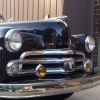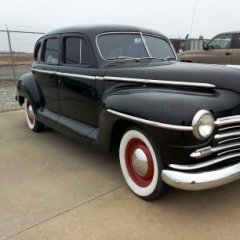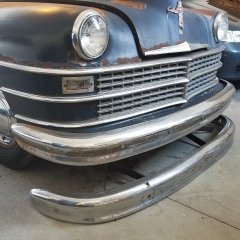-
Posts
28 -
Joined
-
Last visited
Reputation
0 NeutralProfile Information
-
Gender
Not Telling
-
Location
Northeast Pennsylvania
-
My Project Cars
1950 Dodge Coronet
Converted
-
Location
PA
-
Interests
Cars, Bikes
Contact Methods
-
Occupation
Electrical Engineer
Recent Profile Visitors
1,131 profile views
-
The clutch does not shudder at all. I realise that the fluid that has now leaked from the unit has potential to cause the clutch to slip, but I've been having this issue since well before it started leaking.
-
My initial thought was the clutch, but I would have smelled it. And with the size of the hill that I was spinning up, it would have left me in a cloud of smoke and unable to continue driving.
-
As the title states, I'm having issues with the fluid drive in my 50 Coronet. It's been slipping on me for a while, under acceleration and uphill. My fist attempt at a solution was to drain the old fluid and replace it with new ISO 32 hydraulic oil. This didn't seem to help anything at all. My next attempt was to remove some of the fluid and, in its place, top it off with some Lucas Stop Slip. This seemed to offer a noticeable improvement the first time I drove it, but the improvement didn't last very long. On a road trip this weekend, she started slipping pretty badly while going up a large hill on the highway. When I pulled over to check everything out, I saw that fluid had started pouring out. I pulled out the plug to try topping it off before continuing down the road. There was noticeable pressure relieved when I pulled the plug away, and fluid was spewing out of the unit. To avoid losing any more, I plugged it bag up and let it cool off before continuing on my way, with the slipping now worse than before, but still obviously drive-able. 200+ miles later, there was still a large spot on my driveway the morning after I returned home. My goal for this winter is to swap to an overdrive transmission, but there are still some shows I need to get to this summer. Is there any way to easily lock up the fluid drive unit in order to make driving the car more tolerable? I really enjoy the three speed, but the hydraulic coupling is a nightmare. Any other suggestions are greatly appreciated.
-

Advice needed on Carter Ball and Ball dual carb setup
mrahc replied to FourCornersGreg's topic in P15-D24 Forum
Feel free to contact me if you need any help along the way. I've put about 7,000 miles on my setup over the last year and the only issue I've had was losing two of the screws holding down the top of one of my carbs. The head was decked .060" and the intake is water-heated, both of which I would highly recommend. I did Fenton split headers because my stock manifold was cracked, but they sound great with the Smithy glasspacks I put behind them. Good luck!- 37 replies
-
- carter
- ball and ball
-
(and 5 more)
Tagged with:
-
I'm going to make some phone calls to local Mopar guys tomorrow. Of all things, I didn't expect brake parts to be so difficult to find. Thank you guys for even acknowledging my needs! I appreciate it.
-
Front! I guess I should have mentioned that.
-
Yesterday, I started what I figured would be a simple project of replacing the wheel lug studs on my D34 with all right hand thread. When I took the first drum off, the friction material from one of the shoes fell right out. I figured that's no problem, I'll just get a new shoe. Turns out it's damned near impossible to find new brake shoes. Upon inspection of the drum itself, I discovered a pretty bad crack. I planned on converting to discs this winter, but I've got a road trip planned for the end of this month and I don't know if I have the time to work that out beforehand. Does anybody happen to have a drum and a shoe I can buy (or rent)? I'd hate to pay full price for parts I'm only going to use for a few months.
-
That makes perfect sense. I was thinking that the external screw was for a ground wire, but that's going to be power from the coil, and then the distributor body itself grounds to the motor. I guess I'll just have to ground the coil separately. Thanks again.
-
Thanks! But I still can't quite tell what the white wire at the bottom right is attached to underneath your condenser wire. It doesn't look like I've got a terminal in that location.
-
I recently had an issue with my Pertronix ignitor (which is being replaced under warranty), but I had kept my points as a backup. My problem is that I don't remember how the wires were connected, and I stupidly forgot to take pictures before installing. I have also been unable to find any clear pictures of the distributor that I could replicate. Can somebody tell me where the condenser is connected, and where this extra wire is supposed to be attached?
-
I suppose I can update with some progress... Merle, I checked the distributor as you mentioned and everything was as it should be. I also picked up another vacuum advance from a friend of mine, but the diaphragm was in eve worse shape than mine. I'd still like to find a replacement, but the only one I've found is $98 from Kanter, with a $45 core charge. At that price, I'd prefer to attempt making my own diaphragm out of some nylon-backed nitrile. I tried for days to find a vacuum leak, as that still appears to be the most logical answer to this dilemma. I still could not come up with anything and the car still doesn't idle the way it should. Off idle, the car was great for about a month. I drove it 1,300 miles with no issues. Then, all at once, the car started running like garbage...backfiring out of the exhaust and the intake, stumbling, no acceleration. I decided it was probably time for a checkup, so I readjusted the valve lash, changed the fuel filter, checked the plug gaps, synchronized the carburetors, and (still a mystery to me) reset the timing. She runs better now, though not as well as before. The terrible idle persists and it's been detonating. I tried backing off the timing, which didn't fix the detonation, but instead added backfiring, so I returned it back to where I started. The plugs look to me like it's not getting enough fuel, which is consistent with the detonation, but I don't know why this lean condition would start all at once. I'm sick of messing with these carburetors, so I'm in the process of rebuilding a pair of Carter BB. This is where I've run into an issue that I need some advice with. The throttle plate shafts are worn pretty badly, giving noticeable play that will undoubtedly result in a vacuum leak. I've been searching all over for replacements, but it doesn't seem too promising. Instead, I'd like to ream the throttle bodies and insert bushings, but I can't find any information on people having done this with these same carbs. I believe the throttle shafts are 5/16", but I'm not sure if a standard 5/16" bushing kit would meet my needs, as the shafts themselves are worn, and not the throttle body itself. I've considered making a nylon bushing, but I don't know if it would hold up to the combination of heat and gasoline. Any advice on adding bushings to these carbs would be very much appreciated.
-
Merle, I'll double check the distributor, but everything looked intact when I had it apart on Sunday. As for the timing marks on the damper, I found TDC before I even knew that the marks were there, then looked down to mark it and it was already dead on.
-
Don, I synchronized the carbs using the vacuum ports at the base of each carb. I'll try contacting Marty today for more information on his setup. I'm pretty sure I've come across his threads in my endless searching, but thanks for the contact. More time spent wrenching over the weekend left me with nothing but more questions. I removed the vacuum advance and found that the diaphragm is shot, so I need to try to find a new one, or at least a functional one. So, for now, the vacuum advance is disconnected entirely. I purchased a new timing light to confirm the old one was malfunctioning, but, to my surprise, it read the exact same thing. After setting the static timing, the inductive timing lights (connected to cylinder 1 wire) are showing about 50 degrees advance at idle. This can't possibly be correct, but what would cause them to read this way? I advanced and retarded the distributor and in each direction, the motor starts to stumble and die, so I returned it to the same position and the car runs and drives just fine, with some slight detonation under heavy acceleration. I hope I can get that to dissipate by retarding the timing slightly more, but I still can't figure out why the timing light is showing me such an absurd value.
-
rcb, I keep thinking the carb base gaskets are to blame, but spraying ether did nothing, so I don't know why I'm stuck on that. I adjusted the valve clearances pretty recently and just tested compression on all of the cylinders to verify the valves were closing properly. All were between 145 and 155 psi. Plymouthy, The timing light I've been using has an inductive pickup, which I've been putting on the Cylinder 1 plug wire. I suspect that the rheostat on the timing light is faulty, or at the very least needs to be zeroed. The open ports at the base of the carb are where the idle mixture screws are hidden, unless I'm looking in the wrong place. I'll check to make sure there are no vacuum ports that didn't have a nipple on them, and I'll also try venturi vacuum for the distributor again.
-
I've been checking the balance at every step, with the vacuum gauge in the photo. The throttle stops are very sensitive, so I've been careful to keep them balanced along the way. I've only got one port on the manifold, so I've disconnected the distributor each time while taking readings and making adjustments to the carburetors. I've been using a tach/dwell meter connected directly to the coil to measure RPMs. I suppose a clean slate is the logical next step. Do you have any experience with the Pertronix ignitions? When adjusting the static timing by the book, I couldn't get the distributor to light a bulb, so I instead connected a spark plug and based my timing off of that. I assumed this was occurring because it no longer has a mechanical contact point, but is this correct behavior?






